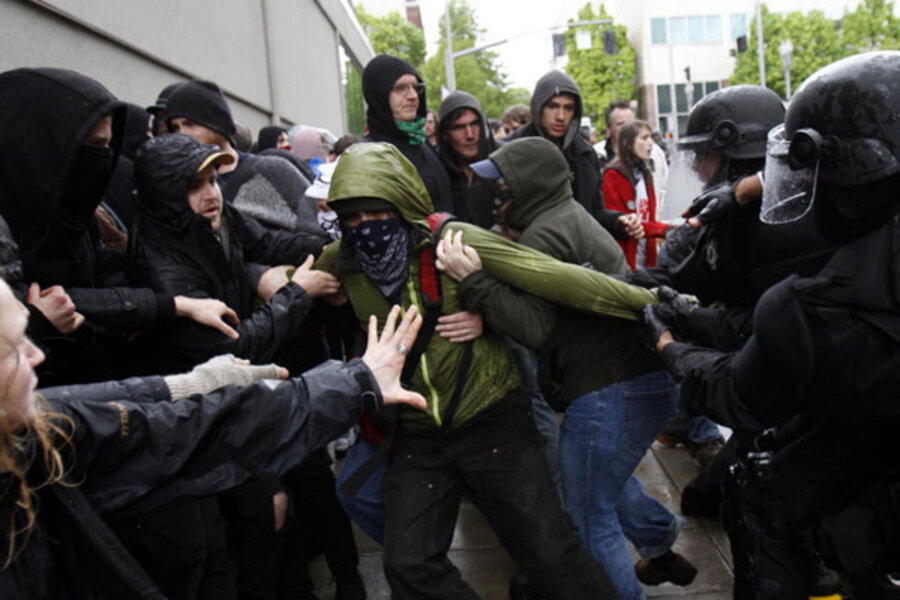May Day: Tear gas in Oakland, broken windows in Seattle
Loading...
Thousands of protesters in New York demanded an end to income inequality and housing foreclosures. Police fired tear gas to disperse marchers in Oakland, Calif. And black-clad demonstrators smashed windows in Seattle.
Activists across the U.S. joined in worldwide May Day protests Tuesday, with anti-Wall Street demonstrators leading the way in some cities as they tried to recapture the enthusiasm that propelled their movement last fall.
While some protesters clashed with police, the melees were far less violent than ones that erupted last fall when the movement was at its peak. Marches and strikes led to a handful of arrests but no major disruptions.
RECOMMENDED: May Day: Occupy movement returns, but can it win converts?
Many of the rallies, which drew activists pushing a variety of causes, also did not have the same drawing power that gatherings had last year for the Occupy movement or a half-dozen years ago for May Day rallies for immigration reform.
In recent years, activists in the U.S. used May Day to hold rallies for immigrant rights, but the day has been associated for more than a century with workers' rights and the labor movement both in the U.S. and elsewhere.
Across the world on Tuesday, protests drew tens of thousands of demonstrators into the streets from the Philippines to Spain. They demanded everything from wage increases to an end to cuts in education, health care and other austerity measures.
The U.S. protests were the most visible organizing effort by anti-Wall Street groups since the movement's encampments were dismantled last fall.
The major developments include:
— In Oakland, the scene of several violent clashes between activists and police in recent months, the situation threatened to boil over again when police fired tear gas, sending hundreds of demonstrators scrambling.
Officers also fired "flash-bang" grenades to disperse protesters converging on police as they tried to make arrests, police said. Four people were taken into custody.
Earlier, some protesters tried to force businesses to shut down for not observing calls for a "general strike."
— In Seattle, black-clad protesters used sticks to smash small downtown windows and ran through the streets disrupting traffic. Police have made at least three arrests.
While much smaller in scale, the mayhem was reminiscent of the 1999 World Trade Organization protests in the city that caused widespread damage to stores and forced the cancellation of some WTO events.
Authorities said many of the most violent protesters were trying to hide in the larger crowd by shedding their all-black clothes after they had caused damage with things like rocks, hammers and tire irons.
— In New York, hundreds of Occupy Wall Street protesters and their supporters spilled out onto Fifth Avenue in a confrontation with police amid citywide May Day protests, while thousands later gathered peacefully in Union Square.
The group had promised the day would mark a spring revival of their movement.
Occupy organizer Mark Bray said the mood had changed since the group's first organized events late last year. "There was a sense of novelty to Occupy in October," he said. "Today is more celebratory, and nostalgic."
Marchers briefly flooded the avenue and blocked traffic before police in riot gear pushed them back onto the sidewalks. The group chanted: "We are the people. We are united!"
— In Chicago, about 2,000 activists marched through the city to demand immigration reform and greater protections for workers. The demonstration was largely peaceful. Half a million people rallied in Chicago in 2006 to demand immigration reform. But numbers since have plummeted to just a few thousand.
— In Los Angeles, hundreds of employees picketed Los Angeles International Airport for a union May Day strike to protest the use of non-union labor. Ten demonstrators who blocked an intersection near the airport were arrested. Downtown, another crowd of hundreds held an afternoon rally for immigration reform and economic equality.
— In Atlanta, about 100 people rallied outside the state Capitol, where a law targeting illegal immigration was passed last year. They called for equal rights for all workers and an end to local-federal partnerships to enforce immigration law.
The rally was significantly smaller than last year's, which drew about 1,000 people. Organizers said turnout last year was greater, in part, because the protest was on a Sunday, rather than during the work week.
"I'm a bit disappointed, but I think this is something to be expected," said Adelina Nicholls, executive director of the Georgia Latino Alliance for Human Rights, one of the main organizers of the rally.
"It's very difficult to keep a high level of excitement going," Nicholls said. "But it's not only about mobilization. It's also about organization, and we have people working every day to promote immigrant rights."
RECOMMENDED: May Day: Occupy movement returns, but can it win converts?







